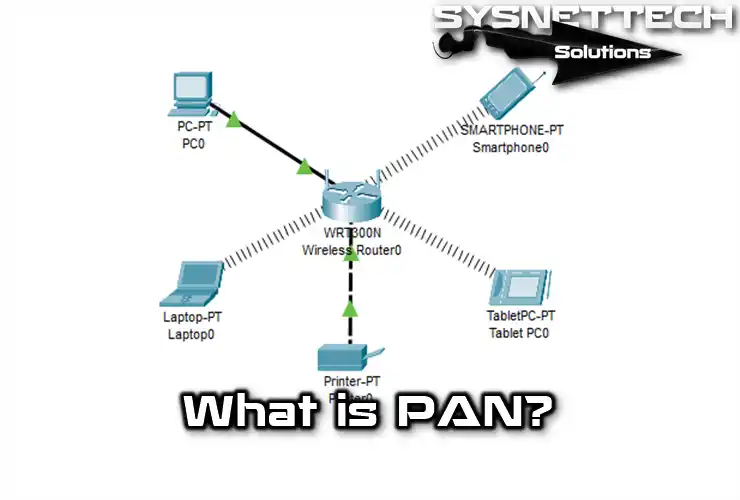PAN (Personal Area Network) is an easily connected structure. It has a basic configuration consisting of devices in the personal and local environment of the users. These users are at home, workplace, car, or shopping malls.

What is PAN Network?
PAN enables device communication within a limited area. It works alongside appliances near you, simplifying information sharing for them. So, you can connect and control other nearby devices with instruments like phones or tablets.
Human-centric networks help people and devices talk to each other. They make wireless connections so you can speak to people far away. Also, these networks focus on making things easier and more accessible for users.
Human-centric networks refer to networks that allow people to communicate with their devices. These networks establish a wireless connection, enabling users to interact with the outside world. Also, Human-centric networks focus on user convenience and accessibility.
The essential features are present in these networks. They belong to all network types, and users consider them the ideal network type for their homes. People often find them in small spaces like homes, workplaces, and offices.
Personal area networks provide communication with the user’s devices at any time. This process happens quickly and efficiently. Various technologies, such as Bluetooth wireless or infrared, allow you to enhance this network.
Also, to fully develop the ease of use of personal devices, these networks must guarantee high security. They should also be highly adaptable to various environments. Or, they can provide a wide range of services and applications for both applications.
Low-bandwidth video conferencing, digital television, and mobile device-supported video games need high-quality multimedia. As a result, the performance of these systems relies on it.
Telecom and PAN
Personal Area Networks (PAN) are a new member of the telecommunications family. They can have capacities ranging from Mbps to Gbps. Wireless PAN (WPAN) is the structure in which communication takes place. It occurs in a completely wireless environment.
People widely use existing WPANs. Application environments are often ad-hoc networks. They need small or non-preconfigured wireless connections. Users must mutually establish these connections.
In short, personal computers, printers, fax machines, and phones are examples of devices used in PAN. People also use PDAs, scanners, and video game consoles in PAN.
History of PAN Networks
They laid out the first foundations of personal networks in 1995. They developed the ability to communicate with connected devices. Also they accomplished this by using stimuli from electrical signals from the human body. Then, MIT (Massachusetts Institute of Technology) introduced this concept.
First, IBM adopted this idea. Then, different research institutions and companies developed many versions.
A PAN Network Structure
PAN enables data communication between a person and devices or other people. So, the architecture of the PAN refers to the user. Different layers cover different connection specifications.
Users achieve PAN connections by combining different network functions with various devices. Thus, performing the bridging function establishes the connection. It enables direct communication between two people.
Users must configure routing and gateway in the PAN. They need this for data communication over an external network. So, the PAN must feature a personal network. It should also support plug-and-play connectivity by users. This seamless setup ensures efficient data communication between devices and external networks.
Features of Personal Area Networks
- It can include both wired and wireless appliances. This versatile network configuration enhances connectivity options so users can connect various devices.
- The network range extends up to 10 meters. So users can connect devices, this limited range ensures secure and localized connections.
- Usually, people make USB or Firewire connections. They use a cable for connectivity. As a result, users can conveniently connect devices. These connections allow efficient data transfer and device interaction.
- You can use your wireless networks more efficiently with technologies such as Bluetooth and infrared. These technologies provide seamless connectivity for devices. As a result, you can connect devices. It enhances flexibility and mobility.
Advantages of Personal Area Networks
You can connect devices since the personal area network does not need extra cables or space. You can start the connection and start sharing data by enabling Bluetooth. Do this on both devices. Thus, PANs provide a convenient and cable-free device connectivity and data-sharing solution.
Users can connect several devices to a single machine. They can also connect a mobile phone or tablet for file sharing.
These networks do not need extra cables. Hence, there’s no more cost involved. Moreover, they are easier to use as they don’t need advanced configuration. The connection remains stable and reliable within 10 meters.
Utilizing this network structure enables seamless data communication. Additionally, it provides cost-effective connectivity for users.
You can protect this network by requiring user authorization. All devices need it before data sharing. So, data piracy is impossible. TV and AC remote controls, as well as other devices, use Infrared technology.
It allows wireless communication within short distances. Thus, it ensures secure data transfer and device control. TV and AC remote controls, as well as other devices, use infrared technology.
One person can synchronize many devices. They can download, upload, and exchange data between different devices. In a wireless network environment, users can move appliances without disrupting data exchange. So, users experience seamless mobility and data transfer between devices.
Disadvantages of PAN
The main disadvantage of this network is its limited range. The signal range and long-distance exchange have constraints. But, for short-range communication, it remains influential. Thus, users should consider the network’s coverage when planning their device connections.
When using infrared and radio signals, interference may occur. Bluetooth and infrared have lower data transfer rates compared to LAN. So, users may experience slower data transmission. But, for short-range communication, they remain reliable.
Related Articles
1) What is Bandwidth?
2)What is the Wide Web?
3) What is the Metropolitan Network?
4) What is the Host?
5) What is a Gateway?



